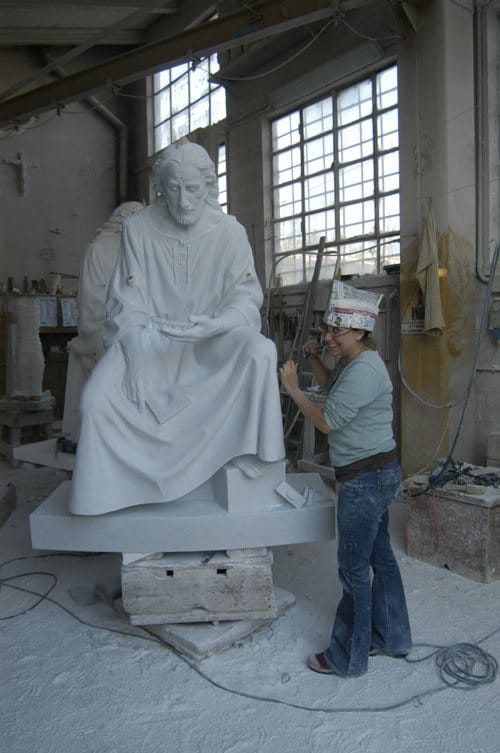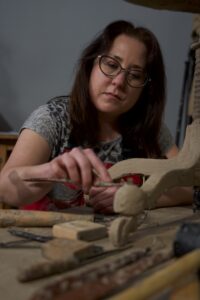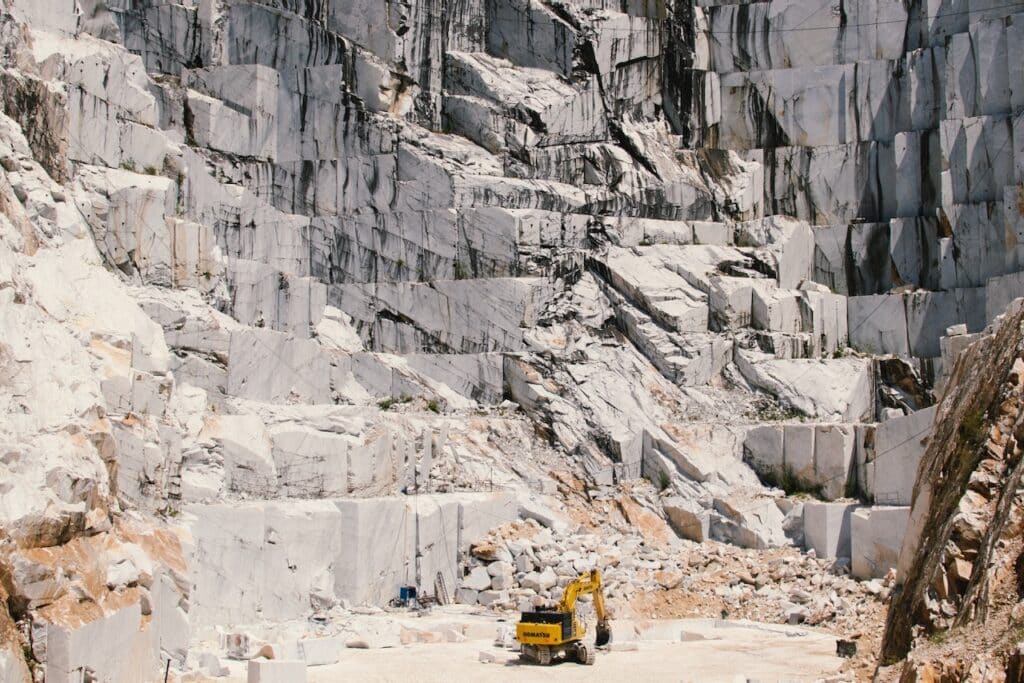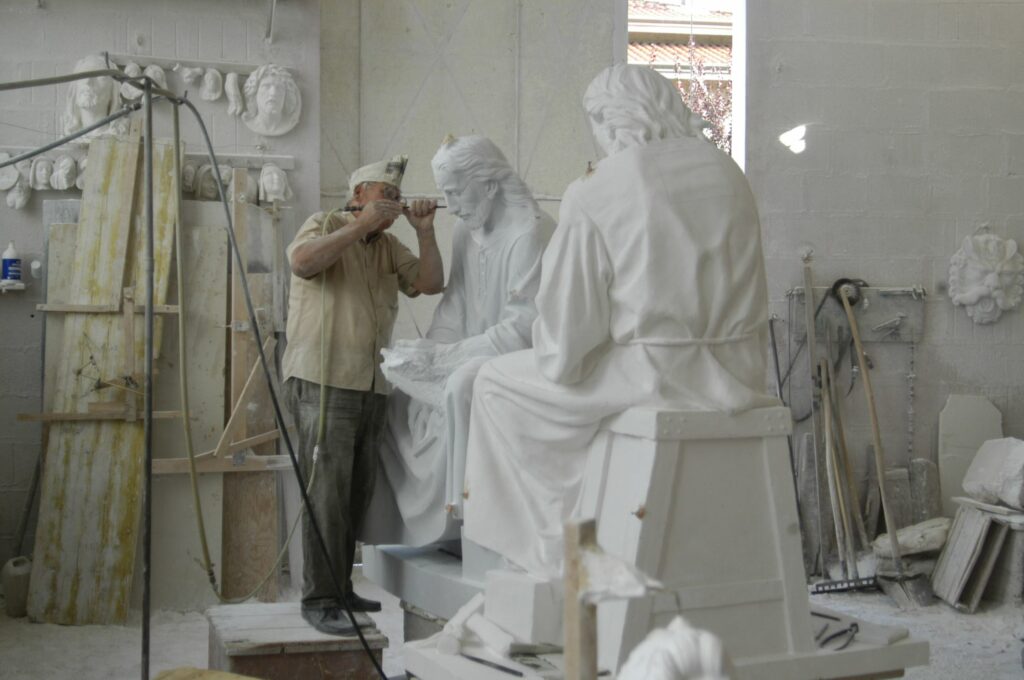An Ancient Tradition

In a world where we have everything at the tip of our fingers– on-demand movies, Amazon one-click buy now, door dash, streaming music– commissioning a marble sculpture can seem like moving a mountain. In a way, it is!
The work at Hempel Studios is a part of a thousands-year-old tradition. The Pantheon in Rome is made from marble from the very same quarries we are using today. Just like Rome wasn’t built in a day, a marble sculpture takes time.
A marble sculpture is an original work of art, made by human hands that will last for millennia. The quality of the work depends on careful planning and tremendous patience. How does a work of marble sculpture come to be?
To Begin: The Consultation
First, consider what you are expressing by having a marble sculpture commissioned. Is to to remember a person? Celebrate a venerable saint? Express your passion for mythology, history, or equestrian life? What is your vision? In the initial consultation, the artist and client exchange ideas and determine whether or not they are a good fit. Sculpture is a creative expression, but it is also bound by the laws of physics and economics.
The Initial Design
The first step is to design the work at a small scale in clay. This is a collaborative process and changes can easily be made at this size. Once the design is approved, the artist develops a plan with a working budget. The cost is be determined by composition, scale, complexity, material, and timeline. A signed contract and a deposit commences the work.
Sculpting in Clay

The first thing is to build an armature in metal, foam, and wood that acts as a skeleton to support the clay. Then the sculptor covers the armature with an oil-based clay called plastilina. It never dries out and cannot be placed in a kiln. She articulates every detail of the sculpture using her fingers and modeling tools. Every inch of the surface is touched by the artist’s hands. Sculpting a large work can take the better part of a year. Once the sculpture is finished in clay, it can weigh close to 1,000 pounds! Once the clay sculpture is approved, it’s time for casting.
Mold-Making and Casting
Next, a casting crew makes a mold. They coat the entire sculpture in liquid rubber in order to make a negative impression. Then the clay is removed. Plaster is poured into the hollow mold. Once it cures, we have an exact copy of the original sculpture! This is called the carver’s model. This part of the process generally takes a 2-3 weeks.
Marble
There is simply no more beautiful material for sculpture than Carrara marble. Marble has almost magical qualities and appears to radiate light from within. It can withstand the elements, though is somewhat more fragile than bronze. Marble is fairly low maintenance. All over Europe there are marble sculptures that have been standing for centuries. It is among the most time-consuming to sculpt, but it has no equal.
Off to Italy…
The plaster carver’s model is then shipped to the carving studio in Pietrasanta, Italy. This takes 2-3 weeks. (There may still be COVID delays at the shipyard.)
Selecting the Marble
While the carving crew waits for the carver’s model to arrive, they will carefully select a piece of statuariomarble from the Carrara Mountains. Artists have been sourcing marble from Carrara for thousands of years. In fact, Michelangelo used this very marble for the Tomb of Lorenzo d’Medici! It’s still the preferred material for the finest statuary.

Carving the Stone
Once the studio receives the carver’s model, they will carve the marble using both traditional tools as well as pneumatic hammers and grinders. They use a pointing machine, or macchinetta di punta, which is not really a machine at all, but rather a measuring device to copy the carver’s model into stone. Using a macchinetta di punta is the traditional manner of carving a sculpture from a carver’s model. When the sculpture is nearly complete, the artist will arrive at the studio to carve the final details herself.
The carving process takes 6-12 months, depending on scale and complexity.

Crating and Shipping the Marble
A professional crating team builds a wooden crate for the final marble sculpture. It is loaded into a shipping container and sent by sea from Italy to the harbor nearest to the site. Once the crate reaches the harbor, it will go through the customs office. Crating, shipping, and customs inspections can take 4-5 weeks.
Delivery and Installation of the Marble
After it has passed inspections and cleared customs, a sculpture rigging outfit will pick up the crate from the port and transport it to the final site. The artist meets the installation crew and the client at the site. Using equipment such as a crane and forklift, the rigging crew will place and secure the sculpture. The installation generally takes 2-3 days.

hi Sarah – we are based in Hong Kong and interested in commissioning a marble sculpture based on a paper boat – size 2 meter in length
Can you let me know if this its something you could do and if so approximately how much do you think that will cost – a very rough ballpark only ?
Thanks for reaching out! I have followed up via email.